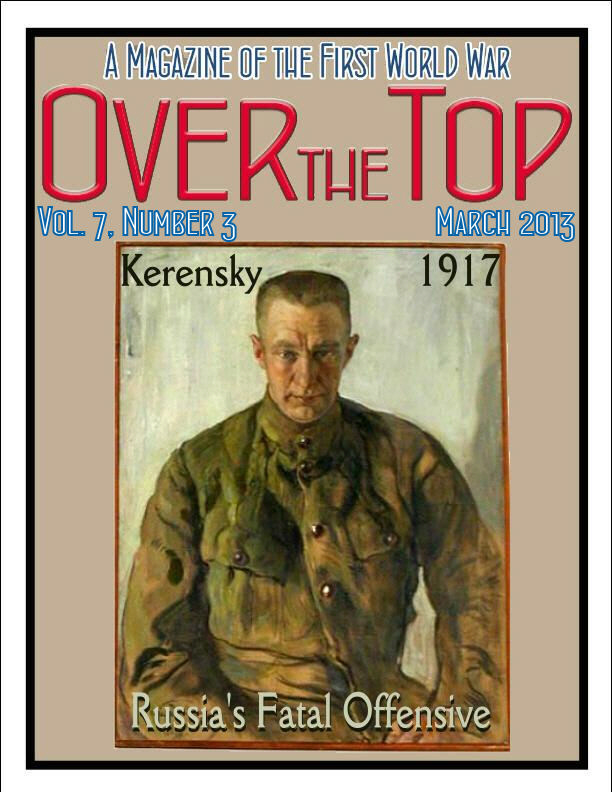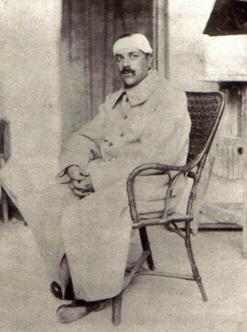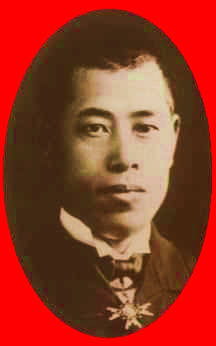


March 1913
Continued Excitement in the Balkans
|
March 1913 saw the end of the First Balkan War, but this did not lead to peace and stability in the region. One of the victors—Bulgaria—would be unhappy with its share of the spoils and would soon precipitate a second regional war. As one astute war correspondent (the name Leon Trotsky should ring a bell) observed, "The Balkan war has not only destroyed the old frontiers in the Balkans, it has also lastingly disturbed the equilibrium between the capitalist states of Europe." The soon-to-be successful revolutionary was spot on.

George I of Greece |
The successes and subsequent expressions of independence by the victorious Balkan states should have alarmed their sponsors, who had taken for granted that they were positioned to manipulate events in the region to their own advantage. As further events would show, their ability to control their proxies in the Balkans had declined much more than they realized.
The ominous assassination of much-admired King George I of Greece on 18 March at the hand of a derelict socialist during a visit to recently liberated Salonika was an alarm bell in the night, as well. It would prove detrimental to Greek politics, and it certainly reminded would-be regicides of the vulnerability of royals and heads of governments while traveling. Mr. Princip and his Black Hand sponsors were surely watching.
|
|
|
TRENCH REPORT: Since the Trip-Wire will cease being the official online newsletter of the World War One Historical Association on 31 March, I've decided it's time for a new look. I have a website designer taking a look at the site and, hopefully, we will be able to implement her recommendations for the April issue. There will be no reduction in the articles and materials we will be presenting. I'm just hoping we will have a more professional and up-to-date look. We will, however, have more and more emphasis on the centennial-related act ivies, events, commemorations, books, videos, etc. MH
News from the World War One Historical Association
Click on Title or Icon to Access
|
WW1HA Election Results
In the 2012 elections to the WW1HA Board of Directors, the following individuals were elected or reelected to three-year terms: David Beer, Dennis Cross, Alan Kaplan, and Robert Xidis. Thanks to all five candidates for being willing to support the World War One Historical Association.
|
2013 Events
The WW1HA New York - New England Branch
2013 Annual Seminar
16 March at the Vassar College Alumnae House in Poughkeepsie, New York. Full Program Now Available: (link)
The 13th Annual General Meeting and Seminar of the WFA Pacific Coast Branch
Held once again in Victoria, BC at the Bay Street Armoury, 8-10 March 2013. The speakers list includes WW1HA stalwarts: Steve Suddaby, Len Shurtleff and Corey Reigel. Online Registration at: (link)
The League of World War I Aviation Historians Has Announced Their 2013 Seminar
Orlando, FL; 14-16 March. Details:
(pdf flyer)
Click on Image to Download Event Flyer
|

Herbert Hoover's presidency (1929-1933) is not—to say the least—highly regarded today. There is, however, no denying his success as U.S. Food Administrator during the Great War when he encouraged over 20 million American families to start Victory Gardens. Without any national rationing, other innovations, like Meatless Mondays, and Wheatless Wednesdays, helped decrease civilian food consumption 15 percent in the States, allowed expanded export of food to allies and for humanitarian purposes, and kept the troops fully fed. His WWI relief and national service, together with later relief work after the Great Mississippi Flood of 1927, allowed the Republican Party to "package" Hoover as the "Master of Emergencies" during the 1928 presidential campaign.
|
British Propaganda Poster

By David Wilson & W.F.B., Date Uncertain
This Month's Internet Feature
Mining Operation
One of the awesome experiences of visiting World War I battlefields is visiting the site of a mining operation. The resulting craters are simply stunning to behold. At a few sites, visitors can get a view of the actual tunnels cutting under the positions of the enemy.
The Technical Aspects of Mining Warfare
Details About British Tunnellers
Vacquois: The Lost Village
Eparges Spur
Lochnagar Crater (Largest on the Western Front)
Survey of the Messines Mines of 7 June 1917
Digging Hill 60 Mines
Hawthorn Mine: The Most Photographed Mine Explosion of All Time
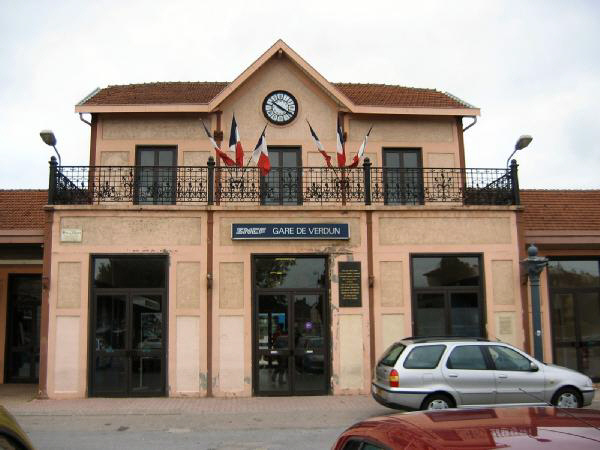
Remember last month's article on Gustav Eiffel? Readers Toni and Valmai Holt wrote and pointed out another interesting connection between the great engineer and the war. Eiffel was the designer of the train station at Verdun (1870). It served as an evacuation hospital during the numerous nearby battles, and was the departure point for France's Unknown Soldier on his journey to Paris after being selected at the Verdun Citadel.

Young Man. . .it is 1700 hrs.
and you would like to know how to
Die
If no better than your elders
At least more piously
For you know death better than life. . .
Apollinaire, Cornflower, 1917
|
|
Page Two
|
|
|

|
Children's Publications During the Great War
When the Great War started in 1914, magazine publishers held a preeminent position when it came to disseminating news. Due to a growing population of literate and news-hungry readers of all ages, there was an enormous market for all kinds of printed material. With the advent of paid advertising in magazines and the means of rapid distribution and cheap printing, by 1914 virtually every niche market segment had publications catering to that particular group.
Children and youngsters too had many kinds of weekly or monthly magazines to read. There were inexpensive and cheaply printed comic book-like weeklies, as well as upper-class literary inspired magazines. Most were more or less profusely illustrated, partially in color, often by talented, but unknown commercial artists. These illustrations were striking and eye-catching, certainly when used as cover art.
Seen now, almost 100 years later, they can seem very bold and show quite violent or often jarring scenes of, for instance, youngsters toting rifles or wielding bayonets, killing enemy soldiers in battle or behind the lines or about to be executed themselves, often in very horrid circumstances. French children's magazines most notably were patriotic to a fault and encouraged the military virtues. Since the war was seen by the French as a struggle for national survival, every member of society was obligated to do their bit. At least so it was seen and portrayed by magazine editors. "Il n'y a plus d'enfants!" (There are no more children!) was a hallmark characteristic of much French publishing for children. Even more or less officially sanctioned schoolbooks or readers brought across this idea to young readers.
In contrast to the militant encouragement of youngsters taking up arms to defend their country, German children's magazines tended to reinforce the idea that war was far too serious a business for children to participate in. Their task was to remain at home and study diligently, help out with chores, and relieve mothers of any anxiety about their absent spouses by being well behaved and studious. Great care was also taken to explain the technical aspects of warfare, how trenches were built and set up, how ammunition was manufactured, and the symbolism of medals and uniforms.
British children's magazines tended to treat the war as a boy's adventure story, with young, plucky, persevering children having the time of their lives and saving the day in some minor way at the end of the day, say, by uncovering a dastardly spy or delivering an important message to the front in time. But whatever the national characteristics may be, one thing is quite certain. The contents and especially the wartime imagery contained in children's magazines during the Great War would be unpublishable in our present day.
TL
|
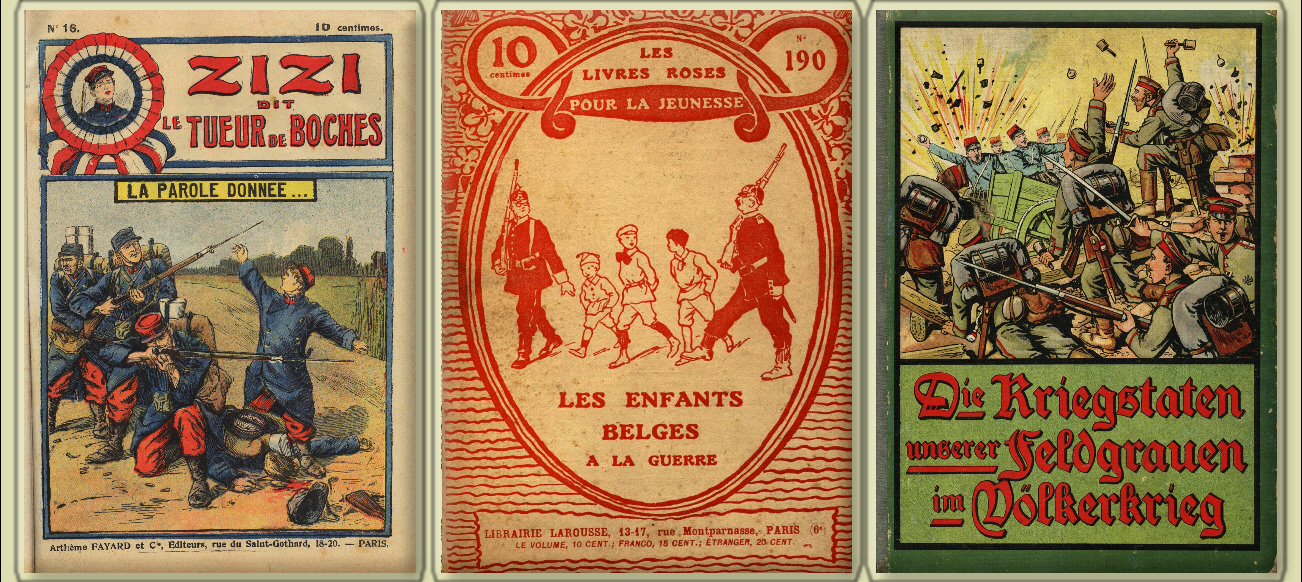
Zizi is a Boy's Adventure Magazine Recounting the Exploits of a Brave and Patriotic French Boy;
A Belgian School Reader During the Occupation; A Boy's Adventure Novel from Germany
|
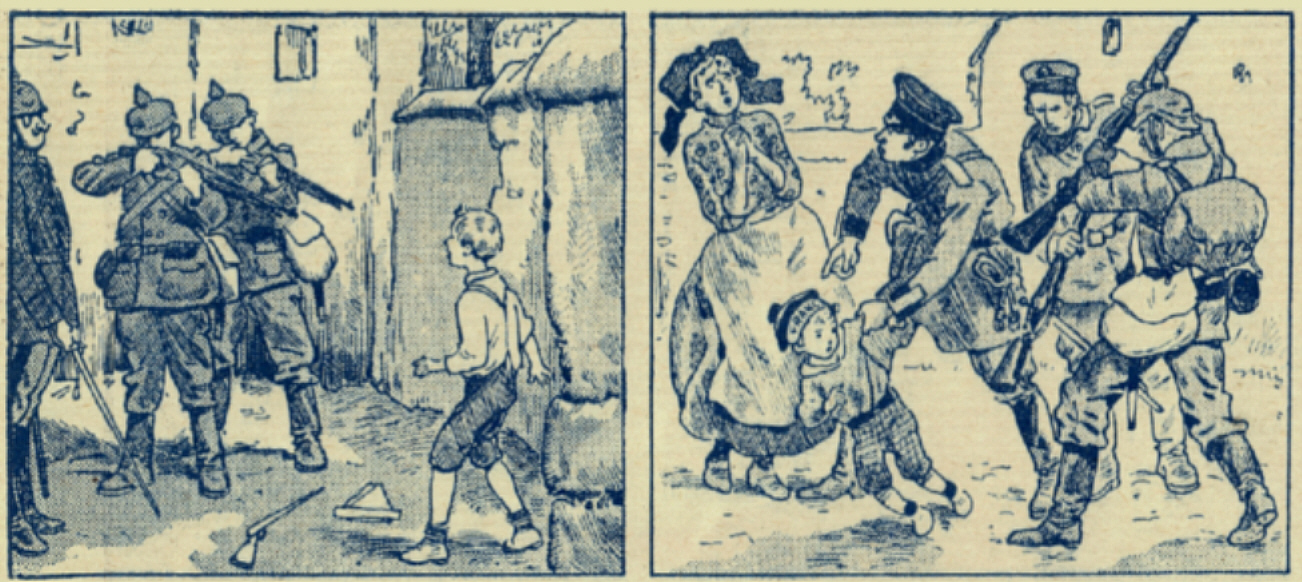
From an Illustrated French History of the War for Young Readers Showing Two Instances of German Barbarity Against Young Children: A Recurring Story of the Execution of a Child for Brandishing a Wooden Gun and the Mistreatment of an Even Younger Child for Having "France" Sewn onto His Cap.
These illustrations, and many more can be found in De Grote Oorlog voor kleine kinderen. Heldenmoed in beeld by Tony and Nicki Langley; ISBN: 978 90 5826 872 3; published in Belgium. While it is not yet available in English, the hundreds of images presented stand on their own. It can be ordered through the publisher's website at:
http://www.davidsfonds.be/publisher/edition/detail.phtml?id=2956
|
|
|
USS Leviathan
A Most Valuable Spoil of War
The first large American troopship to make the Atlantic crossing with troops was the 58,000 USS Leviathan, formerly the German liner Vaterland, owned by the Hamburg America Line. Launched at Hamburg in 1914, she could sustain a speed of 20 knots across the Atlantic regardless of weather. She had 14 watertight compartments, 46 Yarrow coal-burning boilers, and eight Parson turbines driving four 4-bladed propellers measuring 14 feet from tip to tip. Having arrived in New York in July 1914, she was trapped in harbor when war broke out. Three years later, she was seized as soon as America declared war on Germany. Outfitted as a troopship and given its new name and a "dazzle" style camouflage, Leviathan took a test run to Cuba in November. It was deemed fit for service on the Atlantic convoy run. On 15 December 1917 she left her pier in Hoboken in a heavy snowstorm for the crossing, bound for Liverpool. It is reported in the history of this ship that Leviathan had 7,254 troops of the 41st Division plus 2,000 crew on board for this initial trip.
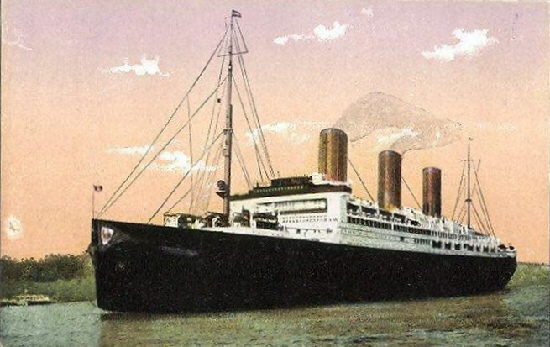
Vaterland in Her Original Glory
Of course, a pilot was mandatory for ships entering Liverpool. On her maiden voyage, to avoid the necessity for her to "lie-to" outside the Mersey river to pick up such a pilot, he was put on board an escort destroyer in Queenstown for transfer to the big ship at the rendezvous. That didn't work, because the weather was so bad in the area that the transfer could not be made. The rough weather prevailed until the ships turned into the Irish Sea, where the transfer was finally made. Both ships maintained a steady course and speed. The destroyer came alongside and a line was passed to the destroyer from the top deck of Leviathan with a bowline in the destroyer's end. This was put around the pilot under his arms. He stood on the outboard side of the destroyer deck just abaft the break on the forecastle. Timed to match the motion of the two ships, he was given a great big run across the deck and was swung aboard through an open cargo port near the waterline of the big ship. Even so, the ship missed the tide and had to wait outside the port while the escorting destroyer ran antisubmarine circles around her. The Leviathan entered port on the morning of 24 December, and the escorts lighted off all boilers to get back to Queenstown for Christmas.
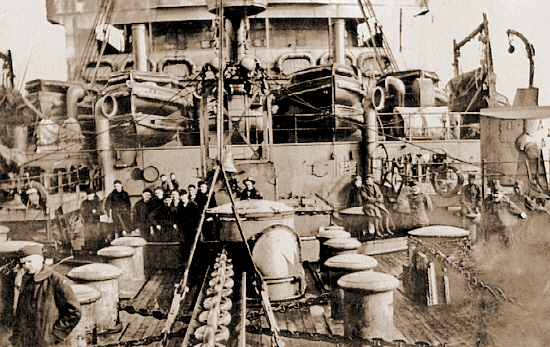
The Deck of Leviathan with Sailors and Doughboy Passengers
(Probably Postwar Voyage)
The escorting destroyers and their personnel had a punishing trip. Some of the escorts lost their forecastle lifelines, had the bridge forward bulkheads buckled and the windows smashed. The navigator of the destroyer with the pilot on board mentions finding the pilot standing in the passageway from the wardroom to the outside deck, where he was going to the bridge for his 4-8 A.M. watch. The pilot, with his spread feet and arms against the bulkheads, was a depressed-looking person. The navigator, trying to make conversation said, "How goes it, pilot?" and he could not be mistaken about the pilot's feeling when after some expressive words he concluded with "Every bone in my bloody body aches from 'olding on in the %#*$@ ship."
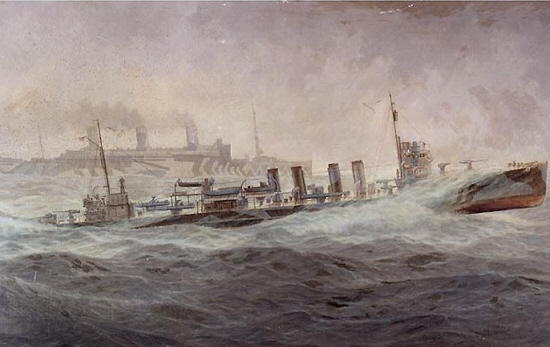
Official Navy Painting:
"A Fast Convoy USS Allen Escorting USS Leviathan
Leviathan would transport 120,000 Doughboys to the front by the Armistice. Its most famous crewman was none other than future movie star Humphrey Bogart, who served on the ship's security detail and reportedly once shot an escaping prisoner while transporting him to Portsmouth Naval Prison. After the war the ship was returned to service as an ocean liner, but as a spoil of war, for the United States Line.
Adapted From the Naval Historical Foundation's Article "Bayly's Navy"
|
|
Albert Ball's Western Front Memorials
Contributed by Steve Miller
Since I began leading battlefield tours in 1991, I have traveled with many "shutterbugs." One of those passengers, however, stands out from all of his fellow enthusiasts. My fellow Air Force vet Steve Miller was simply the most knowledgeable of all about the events of 1914-1918, and he has proved to be the most effective documentarian of the important sites on the Western Front, both renowned and forgotten. Steve has a particular interest in the aviation side of the war. The images and the comments below on Albert Ball are composites from slides and notes he used in a comprehensive presentation on the "Aviation Memorials of the Western Front" made to the League of WWI Aviation Historians. MH
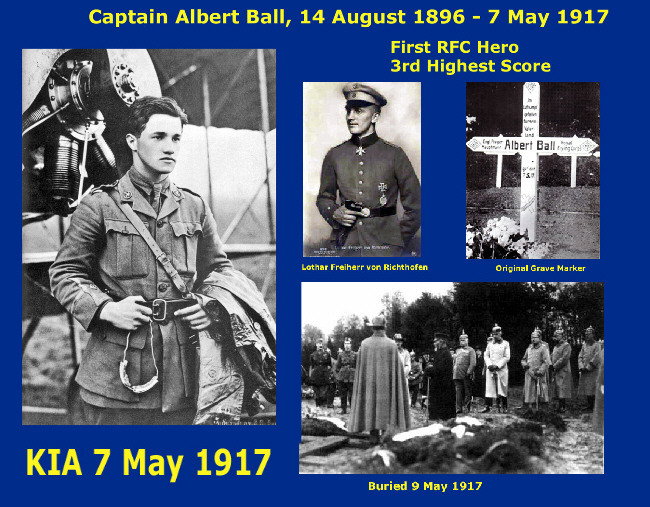
Albert Ball joined the Sherwood Foresters at the outbreak of war, but was disappointed at his assignment at home in Britain. He paid for his own flying instruction and joined the RFC in 1916. Starting out he flew the BE-2 but was able to get into single-seat scouts where he found his role in life.
After rapidly gaining 17 victories Ball was posted home in October 1916 and received much adulation in the press. He was the Royal Flying Corps's first hero after ultimately receiving the Distinguished Service Order with two Bars (i.e., three awards) and the Military Cross. Later, he would posthumously receive the Victoria Cross.
Restless at home, he lobbied for return to combat and was assigned to 56 Squadron in February 1917, flying both Nieuport 17s and SE5s, which he preferred. His preference was for the latter with its twin guns and superior stability. Ball suggested a Lewis Gun mount for the SE5s.
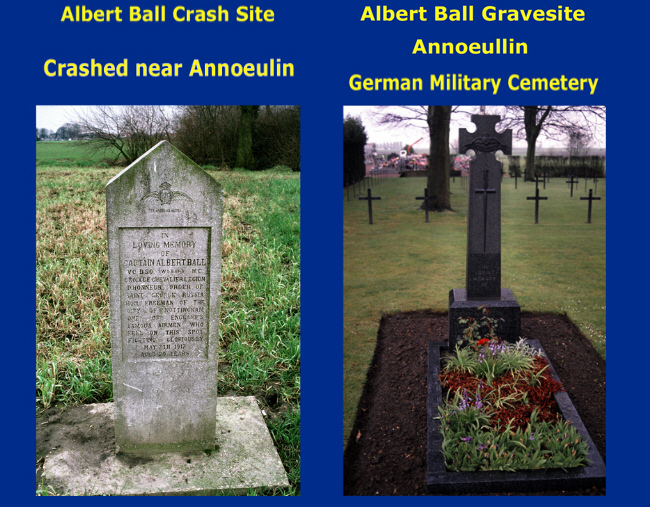
The circumstances of Ball's death are uncertain. On a mission near Annoeullin, 15 km SW of Lille, he emerged inverted from low clouds and crashed in a field. The Germans credited Lothar von Richthofen—the Red Baron's brother—but vertigo is a more likely explanation.
Recognizing Ball's distinguished record, the Germans provided a military funeral. His grave remains in the German extension of the Annoeulin community cemetery—the only non-German burial—with a private memorial provided by his family. His father also purchased the field where Ball's plane had crashed and installed a marker which still stands.
|
|
My World War I Expeditions for Valor Tours, Ltd.

Click on Image to Send Email
|
Page Three
|
|
What Did Houdini Do During the Great War?
|
Another installment of our new feature, "What Did Houdini Do During the Great War?", that focuses on unknown or unlikely participants in the war. (We need a continuous flow of suggested names from the readers to continue this feature.)
Georges Braque (1882-1963)
Artist and Soldier
|
Considered to be the co-founder of Cubism, Georges Braque worked arm-in-arm with Pablo Picasso in developing that revolutionary rejection of the sensual for the analytical in art. However, when war broke out, he enlisted in the French Army and served as an infantryman in the 53rd Division. (Picasso, being a neutral Spaniard, was not required to serve.) Braque received a severe head wound fighting in Artois near Vimy Ridge in 1915 (see photo) and, after a long recuperation, was discharged in late 1916. His only regret about his war service was apparently over his inability to paint during his recovery. He was, though, enormously productive for the rest of his life. Interestingly, Braque seemed to move away from Cubism, the very technique he helped pioneer, in his later work.
|
Theda Bara (1885-1955)
Actress
|
Here's a question for you, dear reader: if Betty Grable was the favorite pinup of WWII's GIs, who held that honor for WWI's Doughboys? The answer could be one of the earliest sex symbols of the silent cinema, Theda "The Vamp" Bara. She grew up in Cincinnati as Theodosia Burr Goodman and became an actress on the New York stage. Fox Studios discovered her and she went on to become their biggest star by the time of America's entry into the war, which was the same year her most famous film, Cleopatra, was released. Theda's brother volunteered for army service and she responded graciously first to his buddies, and then to other units that requested her sponsorship. As with other stars like Charlie Chaplin, Mary Pickford, and Douglas Fairbanks, Theda was also a wholehearted supporter of the war bonds programs and went on to set records for sales. But her most notable connection to WWI might be that she is believed to be the first female personality adopted for aircraft nose art. The image on the right, courtesy of theaerodrome.com, shows a U.S. training aircraft with Theda's name. Theda got married in the early '20s and left her film career. There are no talkies featuring Theda, and, sadly, most of her silent films have been lost.
|

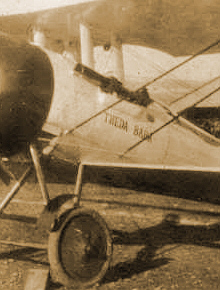 |
Isoroku Yamamoto (1884-1943)
Naval Officer
Japan's greatest admiral-to-be was certainly well-positioned and of the right age to play a major role in his nation's World War I effort. He was a wounded veteran of the great victory at Tsushima, and he had already been moved onto the fast track to high command by his superiors. However, the outbreak of war in 1914 found him at the naval staff college where he was required to complete the curriculum before returning to full-time service. After his graduation in 1916, Yamamoto, now a Lt. Commander, was assigned to the staff of the 2nd Battle Squadron. Nothing of great military moment apparently occupied him during the period leading up to the Armistice, his biographers concentrate on two other personal matters during this period. He was adopted at this time into the distinguished Yamamoto clan (his original surname was Takano) and he was married. Postwar, he would have two well-documented extended assignments to the homeland of his future American adversaries, as a student at Harvard University and, later, as naval attaché to Washington.
|
World War I Headlines
in the 21st Century
|
|
Compressed Air Trench Mortars
Infantry of both sides in the Great War learned to love the trench mortar. And foot soldiers still love to have hands-on, immediate control of what is in effect, short-range light artillery. The early mortars, however, had obvious signatures, smoke and flash characteristics, that made them easy for enemy spotters to locate. One solution was the compressed air trench mortar, which emitted neither smoke nor flash when operated. Here is a French 86mm piece being fired.

|
|
|
 |
The Marne, 1914, the Opening of World War I and the Battle that Changed the World
By Holger Herwig
Reviewed by Clark Shilling
|
A volume from Dr. Holger Herwig should always excite students of the Great War. He is a specialist in military history and has written or co-written several award-winning books on World War I.
There are three good reasons to savor this book. First, this is the most modern account in English of the opening of the war told from the German perspective. Second, Dr. Herwig was able to access German archives long thought destroyed in World War II. These unit histories and archives were actually carried off by the Soviets at the end of the war and were discovered after the collapse of the Iron Curtain. In addition to providing new information on the German effort, these documents allowed Herwig to include personal accounts of the campaign never included in previous writings on the war. Third, Dr. Herwig brings to light new facts about the German attack in the West in 1914. For example, there was much dissension and distrust among the leading German generals. Compounding this animosity was a curious weakness in the communication infrastructure of the German army of 1914, so that often the main units did not know where their counterparts were. Changes in plan were not effectively communicated, thus the great "wobble" in the German wheel as it moved through France.
To this reader, the central point of this book concerns the two leading protagonists in the opening battle of the war, Helmuth von Moltke and Joseph Joffre, and how each coped with "the fog of war"—the tendency for events to overtake plans and cause them to unravel.
Von Moltke had the vaunted Schlieffen plan and Joffre his Plan XVII. Both plans experienced difficulties. In fact, Joffre's plan was a disaster for France. But at the eleventh hour, Joffre recognized the danger overtaking France, and through a Herculean effort he reacted, moving and reenergizing his armies while taking personal control of the battle. He was an aggressive micromanager, visiting the front, pushing his commanders face to face, and firing those he found lacking. In contrast, von Moltke was a hand wringer, remaining isolated far behind the front, communicating through intermediaries, reluctant to interfere beyond making recommendations. Von Moltke lost control of events and saw his plan for victory derailed by Joffre's attack on his flank.
Dr. Herwig calls the Battle of the Marne the battle that changed the world. Germany was denied a quick victory and was forced to fight the kind of war it most wanted to avoid against odds it could not overcome. Deprived of victory in 1914, Germany was compelled to try again a generation later. The Marne was the start of a struggle that ended in a devastated Germany in 1945.
The Marne, 1914, the Opening of World War I and the Battle that Changed the World; Holger H. Herwig; Random House; 2009; ISBN: 978-1-4000-6671-1.
|
|
|
|







